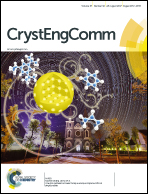Hydrogen-bonded molecular capsules: probing the role of water molecules in capsule formation in modified cyclotricatechylene†
Abstract
Two new pyridine moiety-appended cavitands, CTC(Py)2(OH)2 and CTC(Py)3, were synthesized and characterized. The solid state structures of both cavitands were studied by single crystal X-ray diffraction. CTC(Py)2(OH)2 resulted in a hydrogen-bonded dimeric molecular capsule, entrapping two molecules of DMSO and intervening water molecules that formed hydrogen bonding to DMSO and CTC(Py)2(OH)2. When crystallized in the absence of water, it forms a 2D polymer by hydrogen bonding of pyridine nitrogen and phenolic hydrogen atoms. CTC(Py)3 forms no such capsule.



 Please wait while we load your content...
Please wait while we load your content...